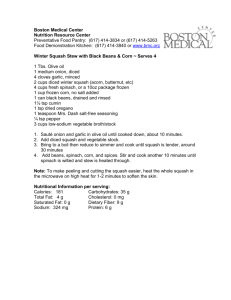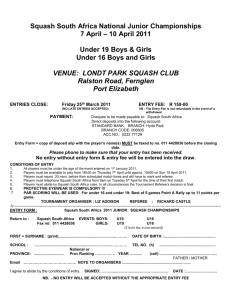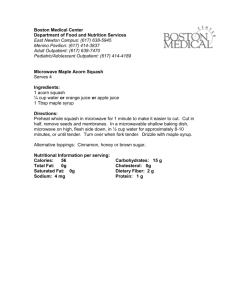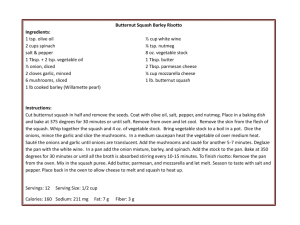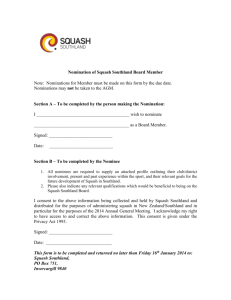Squash Powder: Production & Food Preparation Research
advertisement
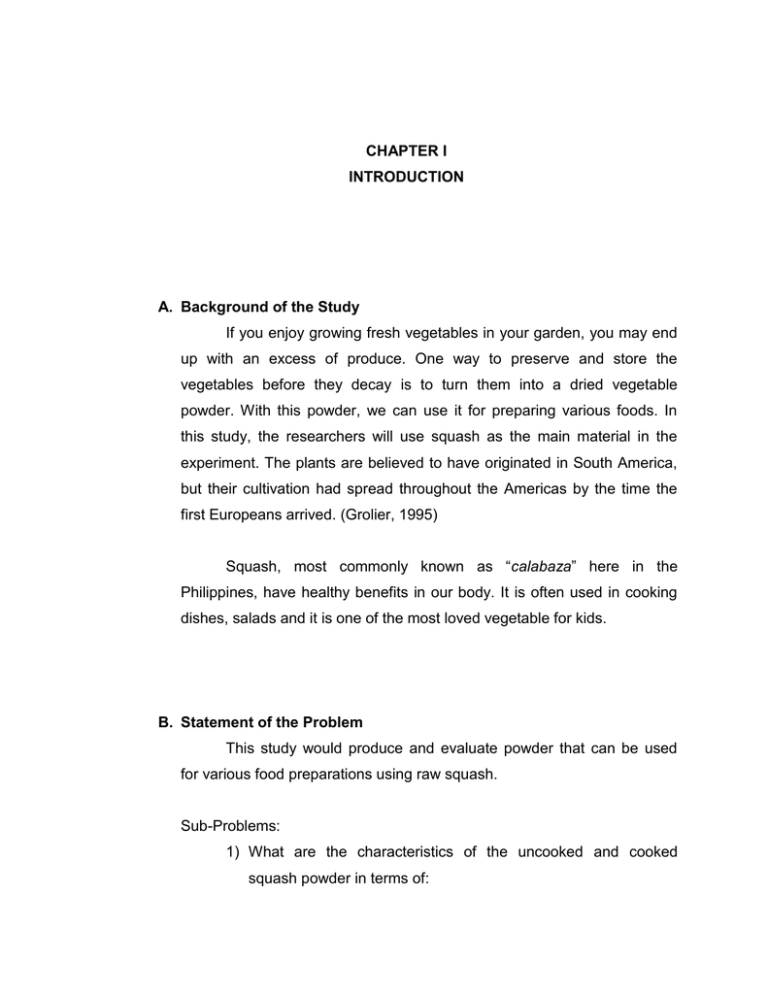
CHAPTER I INTRODUCTION A. Background of the Study If you enjoy growing fresh vegetables in your garden, you may end up with an excess of produce. One way to preserve and store the vegetables before they decay is to turn them into a dried vegetable powder. With this powder, we can use it for preparing various foods. In this study, the researchers will use squash as the main material in the experiment. The plants are believed to have originated in South America, but their cultivation had spread throughout the Americas by the time the first Europeans arrived. (Grolier, 1995) Squash, most commonly known as “calabaza” here in the Philippines, have healthy benefits in our body. It is often used in cooking dishes, salads and it is one of the most loved vegetable for kids. B. Statement of the Problem This study would produce and evaluate powder that can be used for various food preparations using raw squash. Sub-Problems: 1) What are the characteristics of the uncooked and cooked squash powder in terms of: a. Color b. Texture c. Aroma? 2) Is there a significant difference on the characteristic of the uncooked and cooked squash with squash powder in terms of color, texture and aroma? 3) Which food preparation is more suitable for the squash powder in terms of palatability: a. Baking b. Steaming? 4) Is there a significant difference of the palatability of raw squash and squash powder for each food preparation? 5) What other food preparation that can be easily done using squash powder rather than squash in its pure form? 6) Which preservative is better in terms of shelf-life for the squash powder? a. Salt b. Sugar 7) What are the advantages and disadvantages of the squash powder? C. Hypotheses 1) There is no significant difference on the characteristic of the uncooked and cooked squash with squash powder in terms of color, texture and aroma. 2) There is no significant difference of the palatability of raw squash and squash powder for each food preparation. D. Objectives of the Study This study aims to produce a powder that can be used for some food preparations by using the squash as the main material. It also aims to distinguish which food preparation is more suitable for the squash powder in terms of palatability, and also aims to determine which preservative is better in terms of shelf-life for the product. E. Significance of the Study Squash is a rich source of vitamin A. It also contains vitamin B and C, which helps boosting the immune system and prevents colds. It also has calcium, phosphorous, fiber which lowers rates of heart diseases, and carotene, which also prevents cancer, and lung and heart diseases. Farmers can benefit from this study. The framers can make a business out from it. Moms, too, can also benefit from it. They would not be bothered forcing their children in eating their “veggies”, because their children will not notice that they are already eating vegetables which they hate. F. Scope and Limitations Adding squash powder to various food preparations is limited only in this study. The future researchers will produce squash powder; evaluate its characteristics using Score Card and the Hedonic Scale. If this is acceptable, then squash powder will be used to determine which food preparation is more suitable for it in terms of palatability. G. Definition of Terms Aroma It is the scent referring to the pleasant odor of the food. Baking It is the technique of cooking food by dry heating; used for the preparation of making cake, bread, etc. Color It is a physical characteristic of the test subject and/or the finished product. Palatability It is the quality of being pleasant to the taste. Powder form It is the resulting form of the experimented test subject. Preservation It is a method of storing raw or fresh food to avoid spoilage by using preservatives. Preservatives Like sugar and salt, these are used to preserve the food or the powder to avoid spoiling of the product. Pulverization It is the process where the test subject will be reduced to fine powder form either by cooking its juice extract or by grinding. Pure form It is the original form or structure of the product. Shelf-life It is the length of time that the product is given before it is considered unsuitable for use or consumption. Squash It is a vine gourd family of the genus Cucurbita, resembling the pumpkin in its edible fleshy fruit (Webster, 1983). This is the test subject in this study. Texture It is a physical characteristic of the test subject and/or the product; It is the feel of the structure. CHAPTER II REVIEW OF RELATED LITERATURE AND RELATED STUDIES Vegetable powders are used to “tuck more nutrition and flavor into the things people cook” (Willson, n.d.). These days some vegetables and other fruits – mostly spices – like tomato, chili, pepper, and onion, are made into powder for easy use. Vegetable powder can be added to juices or as a base for soups to make it more nutritious (Sundstrom, 2011). It provides value-added thickening for soups (Willson, n.d.). For example, squash. Different Kinds of Squash Squash (Cucurbita spp.), also known as calabaza or pumpkin, from the Cucurbitaceae family, is a genus of gourd plants grown for their fruit. It is related to the family of melons and cucumbers (O’Brien, 2009). It is a cool-to-moderateweather root vegetable with long, lacy leaves reaching about 0.3m (1ft) in height (Grolier Encyclopedia of Knowledge, 2002). It is a very good source of vitamins A and C, calcium and iron. It has very low calories (Nutritional Value of Squash | Healthy Living Tips, 2009). It is also rich in fiber, which lowers rates heart diseases, and protects from colon cancer by working to get rid the body of harmful substances (O’Brien, 2009). Due to its healthy benefits, the future researchers are determined to produce squash powder out of raw squash for easy use. To make this powder last longer, preservatives are added, Preservatives are substances used or added to products to preserve or avoid spoiling of food. They are also called additives. There are available chemical preservatives, but natural preservatives are commonly used. Common food preservatives are salt, sugar and vinegar. The researchers will be using salt and sugar as their food preservatives. Salt has been used as a natural food preservative since ancient times, especially for meat. Salted meat can last for many years. The phenomenon behind adding salt as a preservative is that it dehydrates microbes through the process of osmosis. Thus, it inhibits the bacteria that cause food spoilage. Salt also protects food from yeasts and molds. It increases the “shelf-life” of various food stuffs. Sugar, an organic compound in the form of carbohydrate, has been used as a natural food preservative in many of the food items. Sugar sweetens the food product and inhibits the growth of microorganisms through the phenomenon of osmosis. Foods can be stored either in sugar syrup or in crystallized form, where the food to be stored is cooked in sugar till the point of crystallization. Sugar acts by drawing out water from the bacteria and other microorganisms, which either kills the bacteria or inhibits their growth. Preserving food is accomplished by controlling and where possible the agents of food spoilage are destroyed, in other words, it is a method of storing raw and cooked food for a very long time by using food preservatives. Since the ancient times, people have been using a number of natural products to preserve their foods. But before using the advent of preservatives, food was commonly stored inside clay jars to avoid food spoilage. The earliest preservative that was used was salt, during the Middle Ages. Many processes designed to preserve food will involve a number of food preservation methods. Preserving fruit, by turning it into jam, for example, involves boiling (to reduce the fruit’s moisture content and to kill the bacteria, yeasts.atc.), sugaring (to prevent their re-growth; examples are fruit juices and condensed milk) and sealing with an airtight jar (to prevent recontamination). (Food Preservation, n.d.) Other ways include freezing. Foods which spoil readily are frozen for transportation, and must be kept packed in ice until used (examples: fish and poultry). Smoking is the method where some foods after being salted are hung in a closed room for several hours, where hickory wood is allowed to smother. Examples are ham, beef, and fish. Preserving by oil, examples; sardines, anchovies, etc; Pickling, exclusion of air, canning, drying and vacuum treatment are also ways to preserve food. (Farmer, 1918) A study was conducted on pulverizing a vegetable for convenience. Jubelag’s (2008) study entitled “Carrot (Daucus Carota) Powder for Various Food Preparation”, aimed to make carrots in powdered form for convenience in cooking and the younger ones who does not like eating it, not to notice that they are already taking in carrots, which is a very healthy vegetable. The researcher has produced the carrot powder with table sugar as its preservative, but was not able to make the carrot powder using table salt. It is recommended in this study to find a way for the powder not to affect the food’s taste, color and odor, and to find out the exact amount of preservative, to be added to a given volume of the vegetable’s extract that is to be powdered. Previous studies were made and used different vegetables in making into powder form. From the study above, after producing the carrot powder, the researcher just randomly added the powder to some available food, like ice cream, and just taste to see if the powder is suitable in terms of palatability. The future researchers modify some method for various food preparation, such as baking and steaming, to see if which food preparation is more suitable for the powder in terms of palatability. CHAPTER III METHODOLOGY A. Research Design This research aims to determine the suitability or the acceptability of squash in the form of powder for various food preparations. The research employs experimental research design to develop squash powder. Trial and error will be done to arrive to an acceptable product. B. Materials and Equipments Materials Knife (2 pcs) Peeler (1 pc) Grater (1 pc) Equipments Ingredients meat grinder (1 pc) Raw squash table salt table sugar C. Experimental Set-Up A – Squash Powder only Legend: B – Raw squash only C – Squash powder with Salt D – Squash powder with Sugar Table C1. Rate Table for testing the Shelf-life of the squash products Squash Characteristics Color Aroma Texture A B C D Legend: A – Ginataang Squash B – Cake C – Puto Table C2. Rate Table for Testing the Characteristics of each Food Preparation Food Addition of Raw Squash Color A B C Aroma Texture Powdered Squash Taste Color Aroma Texture Taste D. General Procedure Preparation of Raw Squash Ten or more squashes in different sizes that are fresh, clean and mature will be gathered. It will be washed, peeled, sliced in cubes and grated. Pulverization Process The grated squash will now be air-dried, with the preservatives added, which will remove the water from the grated squash. It will then be grinded using a grinder, to produce the squash powder. E. Product Development Trials will be conducted after each trial to achieve a desired product. The research adviser will evaluate the product and give her suggestions for the improvement and enhancement of the product of the research for each trial. Trials will end until an acceptable product will be achieved base on the evaluation of the research adviser. F. Sampling Design The researchers will use Random Sampling by identifying panel of evaluators using the Fishbowl Technique. The names of the IDS Junior students will be written on a piece of paper, rolled and placed in a bowl. Thirty names will be drawn to evaluate the product of the researchers using the Score Card for the characteristics and the Hedonic Scale for acceptability. G. Instruments in Data Gathering The instruments that will be used in data gathering are the Score Card and the Hedonic Scale. The Score Card is for sensory evaluation of the evaluators; while the Hedonic Scale is for measuring the acceptance for the valuators as shown in the tables below. Table G1. Score Card Scale for the Characteristics of the Squash Powder Description Rating Color Texture Aroma 5 Brilliant Coffee like Pleasant 4 Slightly Brilliant Slightly Coffee Like Slightly Pleasant 3 Average Average Average 2 Slightly not Brilliant Slightly Like 1 Not Brilliant Not Coffee Like not Coffee Slightly Pleasant Not Pleasant Table G2. Hedonic Scale for the Acceptability Rating 9 8 7 6 5 General Acceptability Like Extremely Like Very Much Like Moderately Like Slightly Neither Like Nor Dislike 4 3 2 1 Dislike Slightly Dislike Moderately Dislike Very Much Dislike Extremely not H. Product Evaluation The panel of evaluator will be given the Score Card and Hedonic Scale to evaluate the different samples of squash powder prepared in various ways. The evaluators will rate the desirable characteristics of each sample product by using numerical rating from 1 – 5, where 5 is the highest and 1 is the lowest. Specific descriptions per characteristics were laid out in Table G1 and G2 for easy evaluation and minimize biases. The general/overall acceptability of the samples of squash powder will be rated using Hedonic Scale. The evaluators will rate the samples from 1 – 9 were 1 corresponds to “dislike extremely” which means least accepted and 9 corresponds to “like extremely” which means the most accepted product as shown in Table G2. I. Statistical Tools for Data Analysis The data that will be gathered will be analyzed and interpreted to get the overall rating of the product. The weighted mean will be employed to find the characteristics and acceptability of the different samples of squash powder. Friedman test or Kruskal-Wallis H Test will be used in order to know if there is a significant difference among samples. Mean 𝑋 = 𝑤𝑖𝑥𝑖 𝑁 Where: xi = weighted mean wi = frequency N = total number of respondents X = responses = Sum of all weighted mean For interpretation of results, the following tables below will serve as a guide. Score Card and Hedonic Scale Interpretation Table I1. Score Card Interpretation Guide Mean Rating General Interpretation Description Color Texture Odor 4.20 - 5.00 Excellent Yellow Very Smooth Very Pleasant 3.40 - 4.19 Very good Yellowish Smooth Pleasant 2.60 - 3.39 Good Light Brown Slightly Smooth Moderately Pleasant 1.80 - 2.59 Satisfactory Brown/Brownish Rough Unpleasant 1.00 - 1.79 Poor Dark Brown Very Rough Very Unpleasant Table I2. Hedonic Scale Interpretation Guide Mean Rating General Acceptability 8.12 - 9.00 Like Extremely 7.23 - 8.11 Like Very Much 6.34 - 7.22 Like Moderately 5.45 - 6.33 Like Slightly 4.56 - 5.44 Neither Like Nor Dislike 3.67 - 4.55 Dislike Slightly 2.78 - 3.66 Dislike Moderately 1.89 - 2.77 Dislike Very Much 1.00 - 1.88 Dislike Extremely Collection and Preparation of Materials Washing and peeling of Raw Squash Grating of raw squash Adding of Preservatives Air-dry Grinding Process Finished Product: Squash Powder Figure I3. Flowchart of the Experimental Procedure
